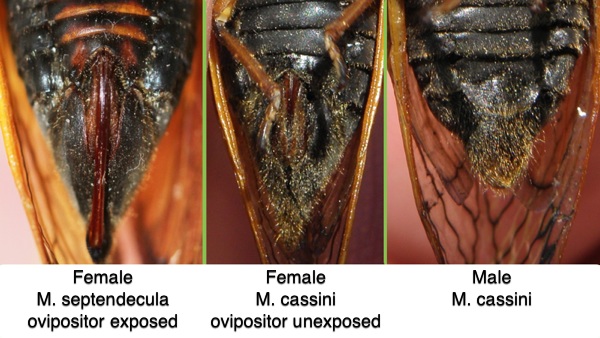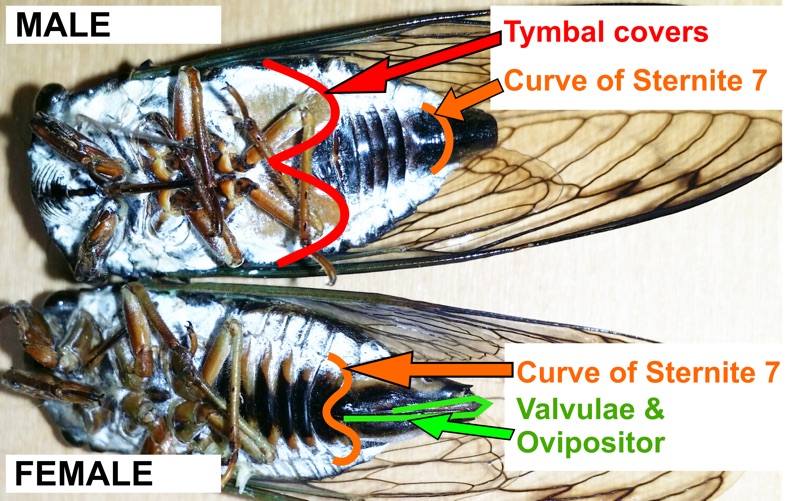Here is how to tell the difference between a male cicada and a female cicada (for most species):
1) Only males sing. If the cicada is singing, it is a male.
2) Look at their abdomen. If it comes to a point and has an ovipositor, it is a female.
This is an image comparing the abdomens of male and female Magicicada cicadas.

This image compares a male and a female Neotibicen lyricen. Note the difference in the curvature of the 7th sternite, the shape & location of the tymbal covers of the male, and the valvulae & ovipositor of the female.
Male and female Neotibicen:

Also, if the cicada is laying eggs in the branch of a tree, that’s proof that it’s a female. Here is a video of that:

I picked up a deceased adult cicada the other day to show my daughter. While I was carrying it around some larvae started wriggling out from inside it. I was tempted to put it in a terrarium and see what was eating the cicada but I decided to keep it outside. I checked on it this morning and a large part of its shell was missing, so whatever it was is gone now. Do you know what insects might lay eggs inside cicadas? I’m located in north western Indiana.
I was so thrilled and privileged to get to witness something I have wished for for a while now. I have seen and handled adult cicadas many times before. I even found a fairly newly hatched one one day. But I have always wished to see a live larval and not just the empty shells. I got my wish tonight and found a live larval and it hatched on my hand. I videoed it and took photos and it was such an emotional and awesome experience. Once the wings were unfurled I put it on a nearby tree. I just checked on her (from what I learned I believe it was a female) and she is still in the same spot on the tree. She is beautiful. I feel so blessed to have experienced this.
I’ve just had the exact same experience! I feel so lucky!!!
When do thhey lay there babys.and when are they born .i would love to see them. I am 64 this is the first time seeing this.
They lay the eggs in grooves they make in branches. You’ll see them if you look at branches. If you can a magnifying glass you should be able to see the eggs which look like tiny rice grains. In about a month, they will hatch.
See Check for first instar periodical cicada nymphs
I know nothing of this insect. My grandson living here in Maryland tells me they are just locust and everybody has them every year. What can I tell him?
Technically they’re not locusts. Locusts are grasshoppers. But over the years people got them confused with grasshopper locusts and the name stuck. There’s a comparison of the two insects on this page: When is a locust not a locust? When the locust is a cicada.
He is right in that there are species of cicadas that arrive every year, but most have shorter lifecycles like Neotibicen tibicen tibicen (Linnaeus, 1758) aka Morning Cicada and Neotibicen linnei (Smith and Grossbeck, 1907) aka Linne’s Cicada.
These are periodic cicadas NOT locusts as locusts are a wholly different insect. There are several different kinds of cicadas. Some are yearly and some are periodic. Brood X is the largest as far as quantity of the cicada groups. They emerge from the ground all at once over several days, every 17 years like Brood X (or 13 years, etc), molt and look for a mate. The males make a high-pitched sound with structures in their abdomens looking for females who make a clicking sound. She lays eggs on twigs. The nymphs that hatch fall to the ground, borrow by the roots where they suck sap until it’s time to emerge again. They are totally harmless to people, animals, and vegetation.
What do cicadas feed on after emergence?
Will males mate with more than one female?
Will females mate with more than one male?
How much longer do they live after mating?
> What do cicadas feed on after emergence?
Mostly if not entirely their body fat. They only need to live a few weeks to a month. They do continue to drink sap, but I’m not sure if they receive much nutrition from it.
> Will males mate with more than one female?
Yes.
> Will females mate with more than one male?
Yes.
> How much longer do they live after mating?
Until their fat supplies run out.
We just recently saw many cicadas and some that were dying did not have part of their body. Are these the females after they have laid the egg? a few of the lets call them joints were missing and rest was hollow.
A lot of times birds or other predators yank their parts off, or their abdomen falls off due to a fungus infection.